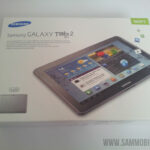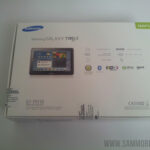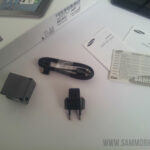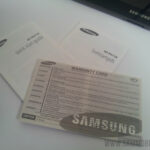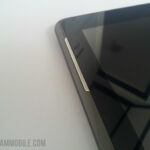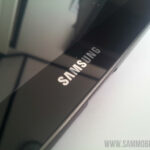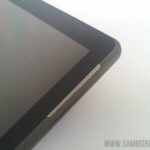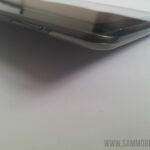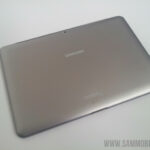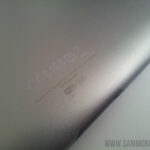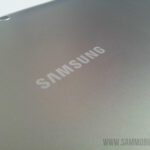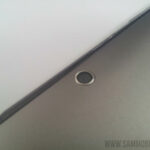This week Samsung gave us the opportunity to review the latest generation of the Galaxy Tab, which is the Galaxy Tab 2.
For this review we used the 10.1 inch WiFi version (GT-P5110). We mentioned earlier through Twitter that we would review the Galaxy Tab 7.7 (GT-P6800) once Android 4.0 is available, but since that the Galaxy Tab 2 is already running on Android 4.0 we decided to take a closer look at the Galaxy Tab 2 first!
Last year Samsung introduced their first 10.1 tablet; the Galaxy Tab 10.1. But one month later, Samsung's main competitor came with a tablet that was much thinner.
Samsung decided to make some changes and the Galaxy Tab 10.1 changed it's name to 10.1v (Vodafone), this version was exclusive available through Vodafone.
But unfortunately the sales weren't that good. One month after MWC 2011, Samsung announced the Galaxy Tab 8.9 and the new 10.1.
Both tablets were decent, packed with dual core chipsets, PLS screens and all packed in a thin and lightweight form factor. The problem was not the hardware but the software, both tablets were running on Android 3.2 Honeycomb, which had an UI that is great for tablets but the performance was pretty disappointing. Even though Samsung was aware of these issues they still introduced 2 new tablets, the 7.0 Plus and 7.7.
In our vision the Galaxy Tab 7.7 is Samsung's real tablet, since it a Super AMOLED panel and it also running on Exynos chipset.
Both are coming from Samsung's own divisions.
Samsung has made smart move with introducing 2 version of it's tablets, a WiFi only and a WiFi plus 3G version.
The advantage of the 3G version is that you can use it outside too, where you don't have WiFi reception.
The advantage is mainly that you can use the internet almost everywhere, but you can use it for making phone calls (but our experience is that you won't do that so quickly since you have to use a headset, or with a 7 inch model you may bring the tablet to your ear).
The price difference between both version were usually between 50 and 100 euros.
Will the Galaxy Tab 2 10.1 be a hit seller? Well It won't be easy but we will do our best to find out what the pro's and cons of this tablet are.
Design.
When you open the box you will immediately see the tablet, we instantly notice that the tablet has a big and nice pair of speakers on the sides.
Probably we noticed the size of the speakers since we are also using a Series 9 laptop of Samsung ourselves.
On the front there is a front facing camera and a light sensor.
At the back you will find the 3 megapixel camera (which takes surprisingly good photos for a tablet).
At the bottom you will find the microphone and a connector for charging and connecting to a PC.
At the top you will find the slot for the Micro SD card, 3.5 mm audio jack and the buttons like a lock button and volume controls.
There is nothing on the left or the right side of the tablet.
Interface.
As you know the Galaxy Tab 2 series are running on Android 4.0. The performance is improved and the user experience is much better than on Android 3.2.
The battery life is also better than the Galaxy Tab's that are running on Android 3.2. On top of Android 4.0 you will find Samsung's Touchwiz interface, which looks better than on the previous Galaxy Tab's.
Unfortunately it's not clear if the previous generation of Galaxy Tab's will also get the same Touchwiz interface, but we assume that these version won't get the latest version of Touchwiz.
In this review you will see some interface comparison with the Galaxy Tab 2 10.1 and the Galaxy Tab 7.7.
The advantage of the Galaxy Tab 2 10.1 with Android 4.0 is the level sensor, the input response is much quicker than on Android 3.2 and the overall experience feels much faster.
The browser is also improved, especially the loading speed of websites. We haven't compared this with the Galaxy Tab 7.7 since this tablet has a faster chipset.
Unfortunately we couldn't compare it with the previous generation of the Galaxy Tab 10.1 since we don't own this tablet at the moment.
At the moment we only have the Galaxy Tab 7.7 and we are waiting of the successor or a version with a 10.1 inch Super AMOLED display.
Back to the interface which has colorful icons like we know from Samsung. Childish?
To be honest, yes, but it's also attractive.
Samsung has improved the looks of the icons since the previous version was quite standard and looks boring but Samsung has improved this to create an interface with a more pleasant look.
Thanks to the Google Play Store you can easily download and install the apps that you want, but be aware that not many apps are suited for tablets due to the bigger screens.
Unfortunately our of own SamMobile app is also not tablet ready (yet).
Even though many apps are not tablet ready we expect that this will change in a matter of time.
Placing widgets, shortcuts or folders is also slightly different from Android 3.2 but thanks to Android 4.0 its a bit easier to do.
Below you will find some interface samples: (Left) GT-P5110 (Right) GT-P6800
Camera
The Samsung Galaxy Tab 2 10.1 WIFI uses a 3.0 megapixel camera. The photos are fine but there is touchfocus. Something we really miss.
For an tablet the quality of the photos is okay, even the recorded video sample looks nice.
It is not like the Galaxy SII or Galaxy SIII but who cares, it is a tablet not an cellphone.
For a tablet are the photo”s fine.
The camera settings are the same basics so no need to talk about it but if you want to see some settings view our movie about the interface of the Galaxy Tab 2 10.1 WIFI
For now we have compared the camera of the tablet with the tablet of the Galaxy tab 7.7.
Next are the photo samples: (Left) GT-P5110 (Right) GT-P6800
Below you will find one video sample which is taken with the Galaxy Tab 2 10.1 WIFI
Speed and battery
The Galaxy Tab 2 10.1 is slightly faster than the previous generation Galaxy Tab 10.1 thanks to the dual core chipset of Texas Instrument. The main difference is also the video playback performance which is much better than the previous generation Galaxy Tab 10.1 which is running on Nvidia Tegra 2 chipset. It's not only the hardware that delivering a better experience but mainly the software (Android 4.0) is responsible for the better performance.
Although the performance is improved we would appreciate if Samsung would use a powerful chipset.
The battery of the Galaxy Tab 2 10.1 WiFi is pretty good which is also important when using a tablet. We didn't notice any battery related issues like unexpected battery drain. Overall we were pleased with the battery performance of the Galaxy Tab 2 10.1 but we hope that Samsung is continuing working on improvements with it's battery life.
Conclusion.
The Galaxy Tab 2 10.1 is a true successor of the previous generation Galaxy Tab 10.1 especially the interface is more pleasing, together with the sound and performance of the Android OS.
But in our opinion we believe that a 7 inch tablet works better but thats because our team is a using thin and lightweight laptops (Samsung Series 9).
In terms of size and how you are using the Galaxy Tab 2 10.1 and a Samsung Series 9 laptop there is not so much difference at all. But if you don't have a thin and lightweight laptop, than we are sure that many people with go for the 10.1 inch version instead of the 7.0, 7.7 or 8.9 inch versions.
Below are the pro's and cons:
Pro's
– Bright PLS display
– Battery life
– Improved Touchwiz Interface
– Android 4.0
– Dual core chipset
– Sound quality
Cons
– Size, if you already have a thin and lightweight laptop
– Just slightly faster chipset
